Question
Mine Case: The first part of the case, presented in Chapter 2, discussed the situation of Computron Industries after an expansion program. A large loss
Mine Case:
The first part of the case, presented in Chapter 2, discussed the situation of Computron Industries after an expansion program. A large loss occurred in 2016, rather than the expected profit. As a result, its managers, directors, and investors are concerned about the firms survival.
Jenny Cochran was brought in as assistant to Computrons chairman, who had the task of getting the company back into a sound financial position. Cochran must prepare an analysis of where the company is now, what it must do to regain its financial health, and what actions to take. Your assignment is to help her answer the following questions, using the recent and projected financial information shown next. Provide clear explanations, not yes or no answers.
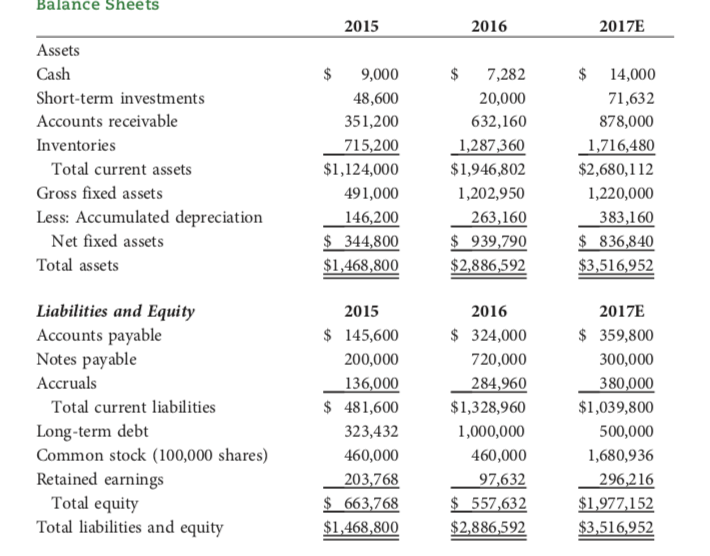
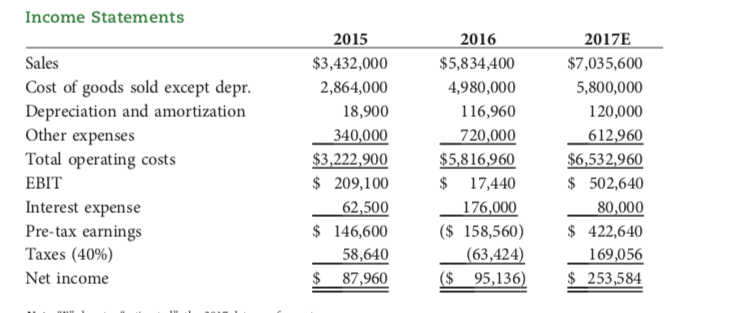

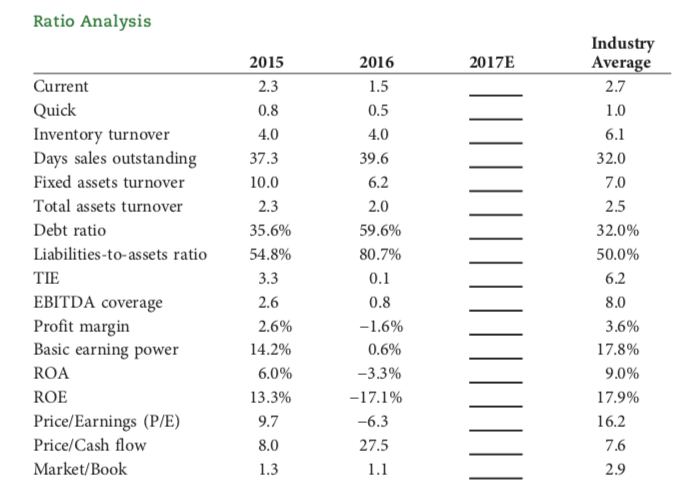
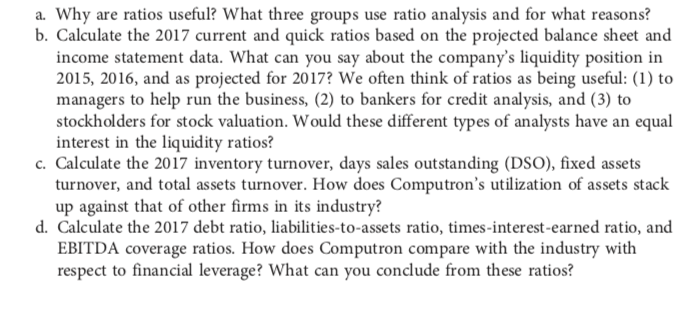
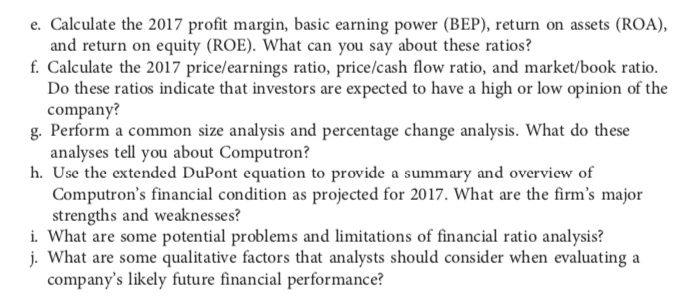
Need help answering D & H
Balance Sheets 2015 2016 2017E Assets Cash Short-term investments Accounts receivable Inventories Total current assets Gross fixed assets Less: Accumulated depreciation Net fixed assets Total assets $ 9,000 48,600 351,200 715,200 $1,124,000 491,000 146,200 $ 344,800 $1,468,800 $ 7,282 20,000 632,160 1,287,360 $1,946,802 1,202,950 263,160 $ 939,790 $2,886,592 $ 14,000 71,632 878,000 1,716,480 $2,680,112 1,220,000 383,160 $ 836,840 $3,516,952 Liabilities and Equity Accounts payable Notes payable Accruals Total current liabilities Long-term debt Common stock (100,000 shares) Retained earnings Total equity Total liabilities and equity 2015 $ 145,600 200,000 136,000 $ 481,600 323,432 460,000 203,768 $ 663,768 $1,468,800 2016 $ 324,000 720,000 284,960 $1,328,960 1,000,000 460,000 97,632 $ 557,632 $2,886,592 2017E $ 359,800 300,000 380,000 $1,039,800 500,000 1,680,936 296,216 $1,977,152 $3,516,952 Income Statements Sales Cost of goods sold except depr. Depreciation and amortization Other expenses Total operating costs EBIT Interest expense Pre-tax earnings Taxes (40%) Net income 2015 $3,432,000 2,864,000 18,900 340,000 $3,222,900 $ 209,100 62,500 $ 146,600 58,640 $ 87,960 2016 $5,834,400 4,980,000 116,960 720,000 $5,816,960 $ 17,440 176,000 ($ 158,560) (63,424) ($ 95,136) 2017E $7,035,600 5,800,000 120,000 612,960 $6,532,960 $ 502,640 80,000 $ 422,640 169,056 $ 253,584 Other Data Stock price Shares outstanding EPS DPS Tax rate Book value per share Lease payments 2015 $8.50 100,000 $0.880 $0.220 40% $6.638 $40,000 2016 $6.00 100,000 $0.951 $0.110 40% $5.576 $40,000 2017E $12.17 250,000 $1.014 $0.220 40% $7.909 $40,000 Ratio Analysis 2015 2017E 2.3 2016 1.5 0.5 4.0 39.6 0.8 4.0 37.3 10.0 2.3 35.6% 54.8% Industry Average 2.7 1.0 6.1 32.0 7.0 2.5 6.2 32.0% Current Quick Inventory turnover Days sales outstanding Fixed assets turnover Total assets turnover Debt ratio Liabilities-to-assets ratio TIE EBITDA coverage Profit margin Basic earning power ROA ROE Price/Earnings (P/E) Price/Cash flow Market/Book 3.3 50.0% 6.2 8.0 3.6% 2.6 2.6% 14.2% 6.0% 13.3% 2.0 59.6% 80.7% 0.1 0.8 -1.6% 0.6% -3.3% -17.1% -6.3 27.5 1.1 17.8% 9.0% 17.9% 16.2 9.7 8.0 7.6 1.3 a. Why are ratios useful? What three groups use ratio analysis and for what reasons? b. Calculate the 2017 current and quick ratios based on the projected balance sheet and income statement data. What can you say about the company's liquidity position in 2015, 2016, and as projected for 2017? We often think of ratios as being useful: (1) to managers to help run the business, (2) to bankers for credit analysis, and (3) to stockholders for stock valuation. Would these different types of analysts have an equal interest in the liquidity ratios? c. Calculate the 2017 inventory turnover, days sales outstanding (DSO), fixed assets turnover, and total assets turnover. How does Computron's utilization of assets stack up against that of other firms in its industry? d. Calculate the 2017 debt ratio, liabilities-to-assets ratio, times-interest-earned ratio, and EBITDA coverage ratios. How does Computron compare with the industry with respect to financial leverage? What can you conclude from these ratios? e. Calculate the 2017 profit margin, basic earning power (BEP), return on assets (ROA), and return on equity (ROE). What can you say about these ratios? f. Calculate the 2017 price/earnings ratio, price/cash flow ratio, and market/book ratio. Do these ratios indicate that investors are expected to have a high or low opinion of the company? g. Perform a common size analysis and percentage change analysis. What do these analyses tell you about Computron? h. Use the extended DuPont equation to provide a summary and overview of Computron's financial condition as projected for 2017. What are the firm's major strengths and weaknesses? i. What are some potential problems and limitations of financial ratio analysis? j. What are some qualitative factors that analysts should consider when evaluating a company's likely future financial performance? Balance Sheets 2015 2016 2017E Assets Cash Short-term investments Accounts receivable Inventories Total current assets Gross fixed assets Less: Accumulated depreciation Net fixed assets Total assets $ 9,000 48,600 351,200 715,200 $1,124,000 491,000 146,200 $ 344,800 $1,468,800 $ 7,282 20,000 632,160 1,287,360 $1,946,802 1,202,950 263,160 $ 939,790 $2,886,592 $ 14,000 71,632 878,000 1,716,480 $2,680,112 1,220,000 383,160 $ 836,840 $3,516,952 Liabilities and Equity Accounts payable Notes payable Accruals Total current liabilities Long-term debt Common stock (100,000 shares) Retained earnings Total equity Total liabilities and equity 2015 $ 145,600 200,000 136,000 $ 481,600 323,432 460,000 203,768 $ 663,768 $1,468,800 2016 $ 324,000 720,000 284,960 $1,328,960 1,000,000 460,000 97,632 $ 557,632 $2,886,592 2017E $ 359,800 300,000 380,000 $1,039,800 500,000 1,680,936 296,216 $1,977,152 $3,516,952 Income Statements Sales Cost of goods sold except depr. Depreciation and amortization Other expenses Total operating costs EBIT Interest expense Pre-tax earnings Taxes (40%) Net income 2015 $3,432,000 2,864,000 18,900 340,000 $3,222,900 $ 209,100 62,500 $ 146,600 58,640 $ 87,960 2016 $5,834,400 4,980,000 116,960 720,000 $5,816,960 $ 17,440 176,000 ($ 158,560) (63,424) ($ 95,136) 2017E $7,035,600 5,800,000 120,000 612,960 $6,532,960 $ 502,640 80,000 $ 422,640 169,056 $ 253,584 Other Data Stock price Shares outstanding EPS DPS Tax rate Book value per share Lease payments 2015 $8.50 100,000 $0.880 $0.220 40% $6.638 $40,000 2016 $6.00 100,000 $0.951 $0.110 40% $5.576 $40,000 2017E $12.17 250,000 $1.014 $0.220 40% $7.909 $40,000 Ratio Analysis 2015 2017E 2.3 2016 1.5 0.5 4.0 39.6 0.8 4.0 37.3 10.0 2.3 35.6% 54.8% Industry Average 2.7 1.0 6.1 32.0 7.0 2.5 6.2 32.0% Current Quick Inventory turnover Days sales outstanding Fixed assets turnover Total assets turnover Debt ratio Liabilities-to-assets ratio TIE EBITDA coverage Profit margin Basic earning power ROA ROE Price/Earnings (P/E) Price/Cash flow Market/Book 3.3 50.0% 6.2 8.0 3.6% 2.6 2.6% 14.2% 6.0% 13.3% 2.0 59.6% 80.7% 0.1 0.8 -1.6% 0.6% -3.3% -17.1% -6.3 27.5 1.1 17.8% 9.0% 17.9% 16.2 9.7 8.0 7.6 1.3 a. Why are ratios useful? What three groups use ratio analysis and for what reasons? b. Calculate the 2017 current and quick ratios based on the projected balance sheet and income statement data. What can you say about the company's liquidity position in 2015, 2016, and as projected for 2017? We often think of ratios as being useful: (1) to managers to help run the business, (2) to bankers for credit analysis, and (3) to stockholders for stock valuation. Would these different types of analysts have an equal interest in the liquidity ratios? c. Calculate the 2017 inventory turnover, days sales outstanding (DSO), fixed assets turnover, and total assets turnover. How does Computron's utilization of assets stack up against that of other firms in its industry? d. Calculate the 2017 debt ratio, liabilities-to-assets ratio, times-interest-earned ratio, and EBITDA coverage ratios. How does Computron compare with the industry with respect to financial leverage? What can you conclude from these ratios? e. Calculate the 2017 profit margin, basic earning power (BEP), return on assets (ROA), and return on equity (ROE). What can you say about these ratios? f. Calculate the 2017 price/earnings ratio, price/cash flow ratio, and market/book ratio. Do these ratios indicate that investors are expected to have a high or low opinion of the company? g. Perform a common size analysis and percentage change analysis. What do these analyses tell you about Computron? h. Use the extended DuPont equation to provide a summary and overview of Computron's financial condition as projected for 2017. What are the firm's major strengths and weaknesses? i. What are some potential problems and limitations of financial ratio analysis? j. What are some qualitative factors that analysts should consider when evaluating a company's likely future financial performanceStep by Step Solution
There are 3 Steps involved in it
Step: 1

Get Instant Access to Expert-Tailored Solutions
See step-by-step solutions with expert insights and AI powered tools for academic success
Step: 2

Step: 3

Ace Your Homework with AI
Get the answers you need in no time with our AI-driven, step-by-step assistance
Get Started


